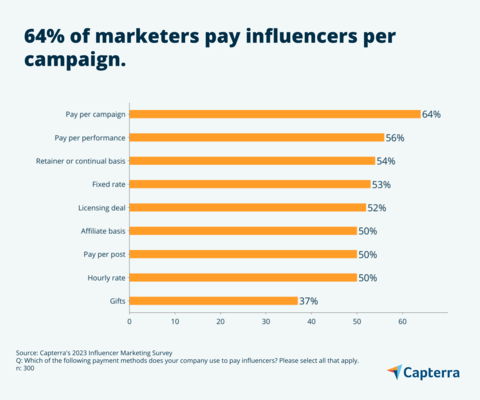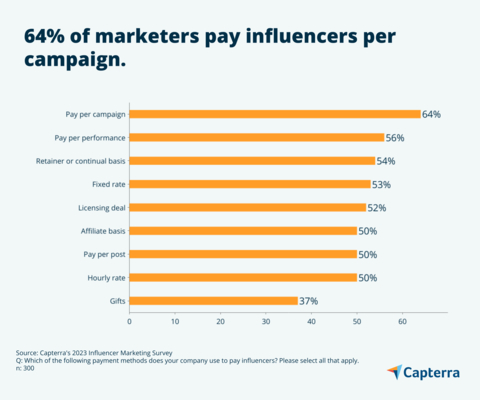ARLINGTON, Va.--(BUSINESS WIRE)--Nearly two-thirds (65%) of marketers plan to increase their influencer marketing budgets in the next six months, according to Capterra’s 2023 Influencer Marketing Survey. While most businesses are maintaining or reducing their overall marketing budgets in response to economic headwinds, this increased spend on influencers indicates that marketers view these programs as worthwhile investments.
Despite the strong interest in influencer programs, many marketers struggle to determine how to pay for these partnerships because of widely varying influencer rates depending on the individual, their engagement, their number of followers, and other factors. Unfortunately, only half of marketers say they feel confident pricing influencers, and 41% believe their company is overpaying influencers.
Influencers themselves have a significant say when establishing a payment method. For example, 90% of marketers say it is extremely common for influencers to help determine their company’s payment method. Currently, the most common form of influencer payments is pay per campaign (64%).
The second-most common form of payment, pay per performance, is leveraged by 56% of marketers. It’s gaining traction as marketers find ways to achieve a clear ROI or promised results, an issue 49% cite as their greatest challenge in working with influencers. This method involves compensating influencers using performance-based metrics, such as sales, clicks, and impressions.
“Pay per performance is becoming more popular for a few reasons, notably because businesses with tight marketing budgets may be more comfortable in only paying for specific outcomes in order to avoid wasting money or additional risk,” says Meghan Bazaman, senior marketing analyst at Capterra. “On the other hand, it also incentivizes influencers to deliver results. And, tracking performance has become easier for both brands and influencers due to advances in marketing analytics.”
Many marketers are also opting for longer-term influencer partnerships. Nearly half (48%) of marketers have set up recurring payments with influencers and 54% are currently paying retainers or on a continual basis. Brand ambassador programs also ranked as the most common type of influencer engagement in Capterra’s survey, further signaling growing popularity for longer partnerships.
To help manage their influencer programs, many marketers have turned to agencies to streamline working relationships with influencers. In fact, 61% report that they currently work with an influencer agency or specialist and another 34% plan to start using one in the next 12 months.
Hiring influencers can be a valuable part of a marketing strategy, but it does come with its own set of challenges and considerations. View the full report on Capterra.com for more tips on establishing an informed payment strategy and leveraging software and agency services to help manage influencer relationships.
About Capterra
Capterra is the #1 destination for organizations to find the right software and services. Our marketplace spans 90,000+ solutions across 1,300 software types, 50,000+ service providers, and offers access to over 2 million verified reviews—helping organizations save time, increase productivity, and accelerate their growth.




